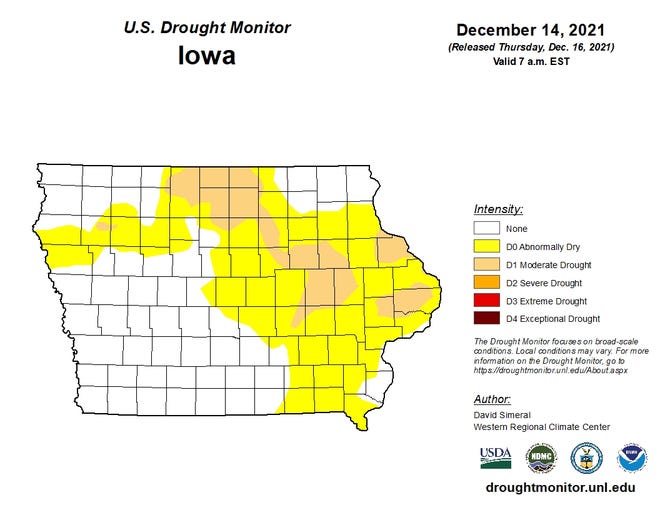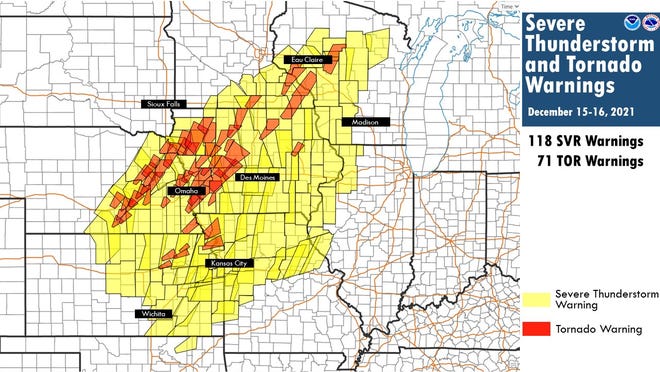Since Christmas is in December, were/are you concerned about the derecho which hit Iowa last December and produced 43 tornadoes with record high temperatures across the state?
Iowa's second derecho in two years spawned 43 tornadoes. Here's how the storm compared to others
Officials have determined at least 43 tornadoes resulted from the Dec. 15 derecho that swept across Iowa — more than seven times the total number of tornadoes to take shape in December in Iowa since 1950, and the most tornadoes in any single day in the state's historical record.
As data from last week's storm — the
first December derecho in U.S. history — continues to be processed, its historic nature becomes clearer. The storm will go down as the worst late-fall or winter thunderstorm in Iowa's recorded history, said Mike Fowle, the science and operations officer at the National Weather Service in Des Moines. It could also rank as one of the worst severe thunderstorms ever recorded in Iowa, regardless of season, he said.
Between 1950 and 2020, only six tornadoes were ever recorded in December in Iowa, according to the NWS. All of them were recorded in southeastern Iowa. Of Dec. 15's 43, 17 were identified as EF2s, with wind gusts of at least 111 mph.
Iowa's previous single-day record of 35 tornadoes was set on Aug. 31, 2014. And meteorologists with the NWS say more tornadoes resulting from the Dec. 15 storm could still be confirmed.
"In the modern era, we haven't seen anything like this in at least the last 75 years," Fowle said. "This is going to be in the upper-echelon of events — anytime you talk 'historic,' you talk the top 5-10% of events."
Iowa wasn't alone in seeing action on Dec. 15: At least 92 tornadoes have been confirmed across Nebraska, Iowa, Minnesota and Wisconsin, according to the NWS. Twenty-seven were confirmed in Nebraska alone.
Meteorologists say a perfect mix created a cocktail ready to produce severe thunderstorms and tornadoes that day. Warm air from the Gulf of Mexico met a powerful low-pressure system as it raced from the central Rocky Mountains, northeast through the Plains and into the Great Lakes, said Peter Rogers, a meteorologist at the NWS in Sioux Falls, South Dakota. Normally in the late fall, warm air from the Gulf of Mexico meets with cold air in the Midwest, reducing the chances for thunderstorms, according to the weather service's storm prediction center.
Des Moines and Waterloo both smashed high-temperature records on Dec. 15, too, with highs of 74 degrees, which handily beat the cities' previous records of 69 and 67 degrees, respectively. Oskaloosa, Muscatine, Iowa City and Ottumwa all set a new record high for the month in Iowa — which was 74 degrees, set on Dec. 6, 1939, in southwest Iowa's Thurman — with highs of 75 degrees.
"Warmer air can hold more moisture, and the more moisture you have available has the potential to increase the severity of storms," Rogers said. "All of that came together at a very odd time of year."
Numerous agricultural buildings sustained severe damage last week, according to damage reports. Vehicles were overturned and some houses had their roofs taken off. Numerous trees and power lines were also damaged.
A tornado hit the middle of Rudd, in the state's northeast corner, heavily damaging a church and library. The tornado that hit Aurelia, in northwest Iowa, caused the most damage out of the 10 in that corner of the state when it tipped over rail cars, collapsed a hog barn and caused other damage, Rogers said.
But population centers like Council Bluffs, Carroll and Sioux City narrowly escaped significant damage. A tornado was confirmed in Sergeant Bluff, just south of Sioux City, and tornadoes touched down on opposite ends of Jefferson, Fowle said; a tornado also landed just west of Atlantic and another clipped a corner of Grand Junction, he said.
No fatalities or injuries were recorded from any of the touchdowns in Iowa, a fact that has astonished meteorologists, although a semitrailer driver was
killed in Benton County, west of Cedar Rapids, when a non-tornadic gust of wind hit his truck and caused it to roll over. In total, five deaths were blamed on the derecho across all states.
Many of the tornadoes were narrow, which minimized the destruction, Fowle said. But there were also several long tornadoes: Four were on the ground for more than 20 miles, the longest being an EF2 tornado that hit Belmond and Meservey and was on the ground for 28 miles. Eleven were on the ground for more than 10 miles.
"Thankfully, the footprint of these towns is fairly small," Fowle said. "In our forecast area, we pretty much missed a direct hit on any town."
Since 1950, the number of days in which tornadoes form across Iowa has diminished, State Climatologist Justin Glisan said. But days with tornado outbreaks are increasing, Glisan said.
On July 14, 26 tornadoes hit Iowa in what was, at the time, the
third-largest single-day tornado outbreak since record-keeping began. Iowa had "basically a lack of severe weather" outside these two storms, Glisan said.
Thunderstorms are an important source of precipitation. Yet
most of Iowa was mired in a drought for the second straight year.
"That's reflected in the drought conditions," Glisan said. "No thunderstorms. No rainfall."







